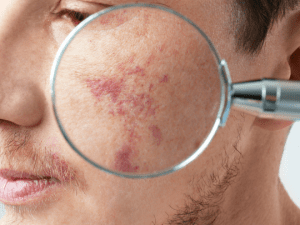What is Squamous Cell Carcinoma?
Squamous Cell Carcinoma (SCC) is the second most common type of skin cancer in Australia. It develops in the squamous cells, which are found in the outermost layer of the skin (the epidermis). While SCC is usually not life-threatening, it can grow quickly and, in rare cases, spread (metastasize) to other parts of the body if not treated early.
Why is SCC So Common in Australia?
Australia’s high rates of SCC are influenced by:
- Intense UV Radiation: The country’s high UV index increases the risk of skin damage.
- Outdoor Culture: Many Australians spend significant time outdoors, exposing their skin to the sun.
- Fair Skin Prevalence: Lighter skin types are more susceptible to sunburn and skin cancer.
What Causes Squamous Cell Carcinoma?
The main cause of SCC is prolonged exposure to ultraviolet (UV) radiation, including:
- Natural Sunlight: Particularly during peak UV hours (10 am to 4 pm).
- Artificial UV Sources: Such as tanning beds.
Additional Risk Factors Include:
- Chronic Sun Exposure: Especially in outdoor workers.
- Actinic Keratosis: Precancerous lesions that can develop into SCC.
- Fair Skin, Light Hair, Blue or Green Eyes
- Older Age: Skin damage accumulates over time.
- History of Skin Cancer: Increased risk of new cancers.
- Weakened Immune System: E.g., organ transplant patients.
- Exposure to Carcinogens: Such as arsenic or radiation.
- Chronic Wounds or Scars: SCC can arise in areas of chronic inflammation or scarring.
What Does SCC Look Like?
SCC can present in several ways, including:
- A scaly red patch with a rough, crusted surface
- A firm, raised nodule that may be tender
- A sore that doesn’t heal or repeatedly bleeds
- A wart-like growth
- A scaly, rough patch on the lips (Actinic Cheilitis)
SCC often appears on sun-exposed areas, including the face, ears, neck, arms, and hands.
How is SCC Diagnosed?
If you notice any suspicious skin changes, visit a doctor. They may:
- Conduct a visual examination using a dermoscope.
- Perform a skin biopsy to examine the tissue under a microscope.
Early detection is crucial to prevent the cancer from spreading to deeper tissues or other parts of the body.
Treatment Options for SCC
- Surgical Treatments
- Excision: The cancerous lesion and a margin of healthy skin are removed.
- Mohs Micrographic Surgery: Offers the highest cure rate by examining the skin layer by layer under a microscope. It is especially useful for SCCs on the face or in high-risk areas.
- Non-Surgical Treatments
- Curettage and Electrodessication: Scraping away the tumor and using heat to destroy remaining cancer cells may be suitable for small, low-risk SCCs.
- Cryotherapy: Freezing the cancer cells with liquid nitrogen.
- Photodynamic Therapy (PDT): Effective for superficial SCCs using light-activated medications.
- Radiation Therapy
- Often used for inoperable cases or for elderly patients who may not tolerate surgery well.
What is the Prognosis for SCC?
When detected early, the prognosis for SCC is excellent, with cure rates of 95% or higher. However, if left untreated, SCC can invade deeper tissues and, in rare cases, spread to lymph nodes or other organs.
How Can You Prevent SCC?
Adopt the Slip, Slop, Slap, Seek, Slide approach:
- Slip on sun-protective clothing.
- Slop on SPF 30+ broad-spectrum sunscreen.
- Slap on a wide-brimmed hat.
- Seek shade during peak UV hours.
- Slide on UV-protective sunglasses.
Additionally:
- Avoid Tanning Beds.
- Regular Skin Checks: Self-examine your skin and see a dermatologist for professional skin checks, especially if you are at high risk.
When Should You See a Doctor?
If you notice:
- New or changing skin lesions
- Sores that don’t heal
- Scaly or rough patches, especially on sun-exposed areas
- Growths that bleed or crust
Early consultation with a healthcare professional can make a significant difference in treatment outcomes.
Key Takeaway
Squamous Cell Carcinoma is a common and potentially dangerous skin cancer if left untreated. By practicing sun safety, performing regular skin checks, and seeking early treatment, you can significantly reduce your risk and ensure the best possible outcome.







